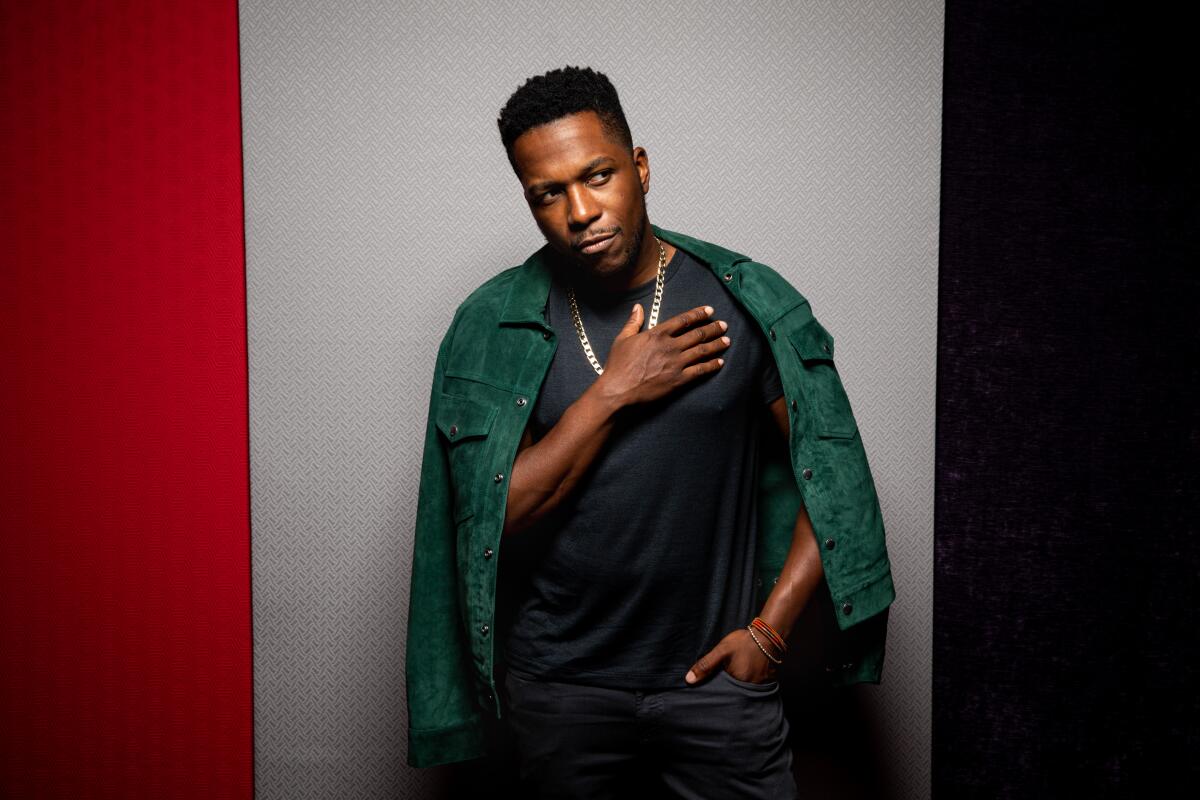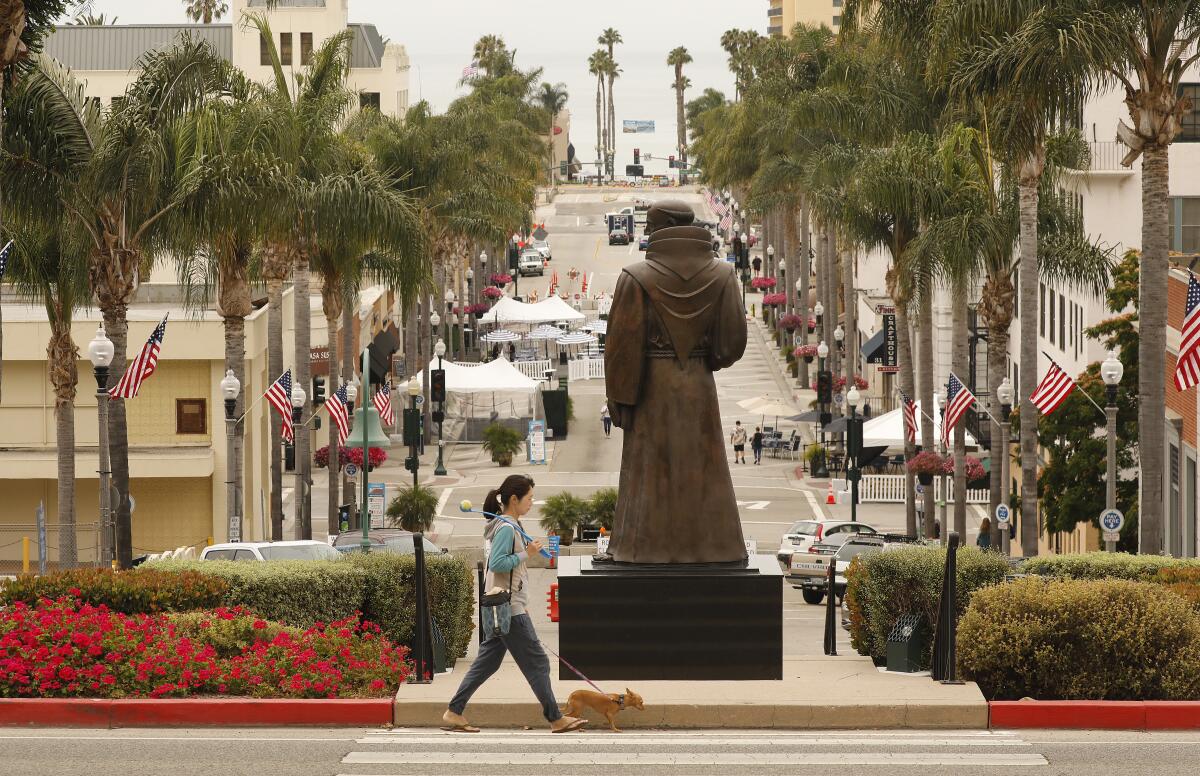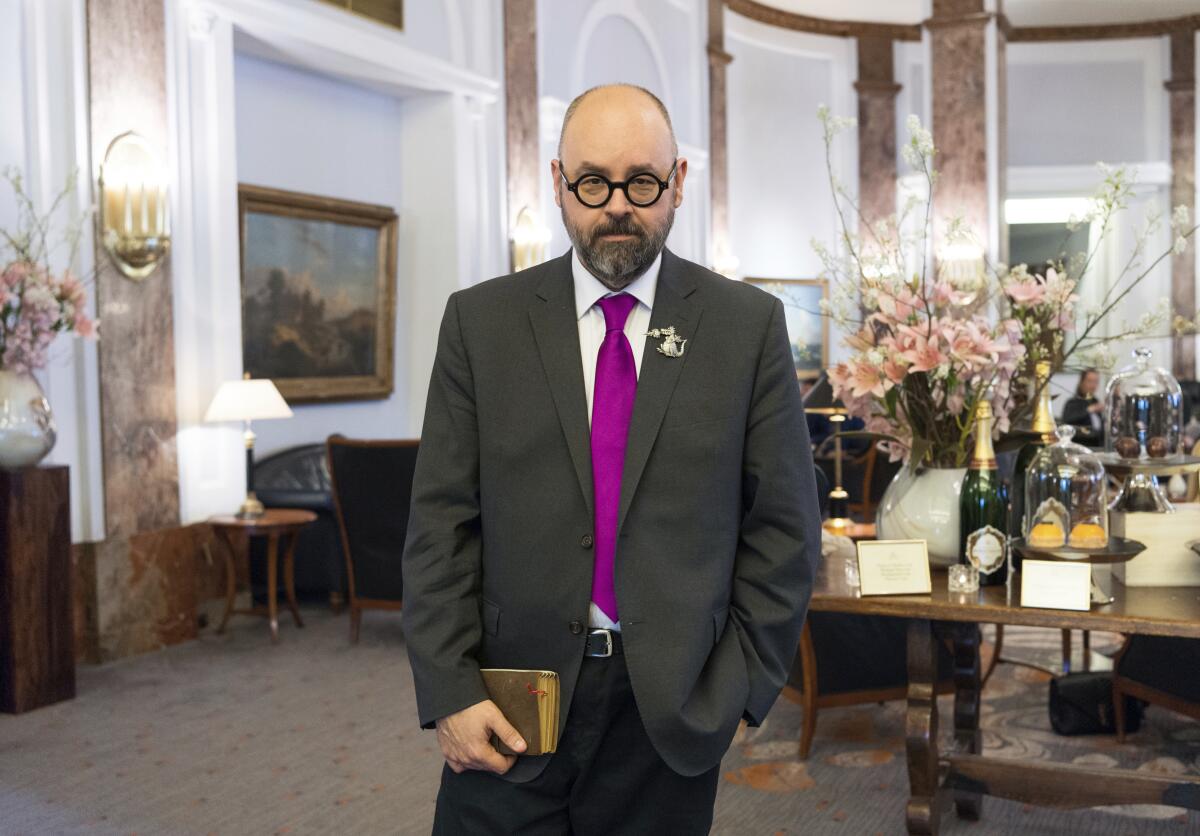Essential Arts: ‘Hamilton’s’ Leslie Odom Jr. and playwright Antoinette Nwandu talk equity

- Share via
Ready for the weekend? I’m Carolina A. Miranda, staff writer at the Los Angeles Times with the week’s essential culture coverage — and bouncy jazz.
Talking about the stage
The Times’ Ashley Lee has a great interview with Tony Award-winning actor Leslie Odom Jr., who was in the first-run Broadway cast of “Hamilton” as Aaron Burr against Lin-Manuel Miranda‘s Alexander Hamilton. Odom helped make sure that the actors’ contracts included profit sharing for the filmed version of the musical (which lands on Disney+ next week). “We need to talk about racism and white supremacy in theater,” he says. “We need to talk about the money.”
More great conversation: The Times’ Makeda Easter spoke with playwright Antoinette Nwandu, whose award-winning “Pass Over” nods to Trayvon Martin‘s death and Samuel Beckett’s “Waiting for Godot.” (A version filmed by Spike Lee is streaming on Amazon.) Last year, a staging of the work at the Echo Theater in L.A. was canceled because of troubles between the play’s Black director and the theater’s white producers. What is needed to make theater more equitable? “The complete upheaval of leadership at institutions of every size,” says Nwandu.
Classical notes
Concert halls are making a comeback in Europe. The Vienna Philharmonic is back in business, the Ravenna Festival is underway in Italy and the Salzburg festival will be up and running in August (though in more modest form). Classical music critic Mark Swed has been tuning in remotely, and while he finds the regimented nature of concerts in the age of coronavirus rather dispiriting, he also says he found something “real and astonishingly stirring” in performances led by Zubin Mehta and Mirga Grazinyte-Tyla. “Some of that had to do with the moment, which was genuinely moving,” he writes. “Much of it, however, had to do with seeing two conductors close to Angelenos’ hearts.”
Monuments continue to fall
Last week, the City of Ventura announced it would remove a statue of Junipero Serra, the Franciscan friar who helped establish the California missions, from its plinth outside of city hall. In the days after, protestors in San Francisco and L.A. tore down statues of the Spanish priest.
Make the most of L.A.
Get our guide to events and happenings in the SoCal arts scene. In your inbox every Monday and Friday morning.
You may occasionally receive promotional content from the Los Angeles Times.
Serra remains a painful symbol among indigenous people, says Tatavium/Chumash elder Alan Salazar, who led a blessing at the Los Angeles action. “My family was brought to the San Fernando mission in 1799,” he told me. “So when I talk about Native people who lost their culture, their language and their lives — and were worked like slaves at the missions — I’m talking about my great-great-great-great-grandparents.”
As organizer Jessa Calderon told L.A. Taco: “This is just the beginning of healing that needs to occur amongst our people.”
Some indigenous activists have said that the statue of Serra in Mission Hills (which shows the Catholic saint with his arm around an indigenous boy) needs to come down. The historic missions are now on guard over the possibility of further topplings of Serra monuments.

For the first time, the National Trust for Historic Preservation has expressed support for the removal of Confederate monuments from public spaces. Makeda Easter spoke with the organization’s president Paul Edmonson, who said “it was about time ... that we took a second look at the positions that we’ve taken in the past on Confederate monuments.”
Hanif Abdurraqib has a stirring essay about the fate of the statues of Christopher Columbus in his hometown of Columbus, Ohio, and what it means to get rid of old monuments as we consider new ones.
New York Times art critic Holland Cotter says that some monuments definitely need to go — but others may require context.
Case in point: a statue of Abraham Lincoln in Washington, D.C., standing over a kneeling Black man, a monument that was intended to honor emancipation. Some protestors say it should be removed. But its legacy is complicated: The statue’s design was overseen by an all-white committee, but it was paid for by African Americans (including former Union soldiers who had been enslaved), and Frederick Douglass attended its unveiling.
Meanwhile, the Washington Post is reporting that President Trump wants to deploy U.S. marshals to protect monuments. Marshals, who are part of the Department of Justice, typically provide security for courthouses, apprehend fugitives and protect witnesses.
“What is a monument but a standing memory? An artifact to make tangible the truth of the past. My body and blood are a tangible truth of the South and its past.” An essential essay from Caroline Randall Williams on the difference between rewriting and reframing the past — and how her fair Black skin is evidence of the ways of slavery and Jim Crow.
Culture and coronavirus
Some cultural institutions remain shuttered, but a new art venue called Compound is planning to open in Long Beach in the fall (with safety measures in place). The space, reports Deborah Vankin, will include two exhibition spaces, a sculpture garden and a restaurant — and is funded by philanthropist and interior designer Megan Tagliaferri. Lauri Firstenberg, former director of LAXArt, will serve as artistic director, and initial exhibitions will feature work by Glenn Kaino, Helen Pashgian and Eamon Ore-Giron, among others.
San Francisco’s de Young Museum plans to reopen in early July, followed shortly thereafter by its sister institution, the Legion of Honor.
Barcelona’s Gran Teatre del Liceu reopened for its first concert since mid-March — to an audience of plants.
Enjoying this newsletter? Consider subscribing to the Los Angeles Times
Your support helps us deliver the news that matters most. Become a subscriber.
There are also cancellations: the Kennedy Center has canceled most performances through 2020. The 43rd annual Kennedy Center Honors will be held in March 2021.
And the Philadelphia Museum of Art plans to lay off 100 employees — more than 20% of the staff.
In the world of architecture, critic Justin Davidson writes on the failures of nursing home design: “We have erected a vast apparatus of last-stop living arrangements that, during the pandemic, have proven remarkably successful at killing the very people they were supposed to care for.
And since we’re all going to likely be spending much more at-home time: California Sunday has a good portfolio of photographs exploring different concepts of home.
The best arts online
A coalition of 13 international art institutions has come together to stream Arthur Jafa‘s video work “Love is the Message, the Message is Death” for 48 hours through Sunday. Participating museums include the Hirshhorn Museum in D.C., the Dallas Museum of Art in Texas and the Museum of Contemporary Art Los Angeles. The searing 7½-minute work, set to Kanye West‘s “Ultralight Beam,” channels the joys and violence of the Black experience in the U.S. (watch it on MOCA’s site).
Washington Post critic Sebastian Smee describes it as a work that alternates “between familiar and obscure, raw and polished, riveting and sickening, athletic and physically crippled, recent and removed in time.”
Absolutely, positively do not miss.
In celebration of Pride, Broadway HD and Lincoln Center have put the Tony-nominated revival of “Falsettos” online — for only 24 hours. (You have until Saturday at 5 p.m.) Catch that and many more offerings on Matt Cooper‘s regular listing of arts and culture online.
Find many more listings on our Things to Do: Arts and Culture page.
Passages
Carlos Ruiz Zafón, the Spanish writer who briefly worked as a screenwriter in Los Angeles but was best known for his novels, including the bestselling “The Shadow of the Wind,” has died at 55.

Paul Fortune, the Los Angeles designer who catered to a long list of boldface clients (such as Marc Jacobs and Aileen Getty) and designed the interiors of storied spaces such as Les Deux Café, has died at 69.
In other news
— USC‘s dean for the School of Dramatic Arts resigned after an alumna revealed that the two had had a relationship when she was a student.
— Arson is suspected in a fire that damaged “Spire,” a wooden sculpture by Andy Goldsworthy in San Francisco’s Presidio. It’s unclear what the long-term damage will be, but the artist tells Jori Finkel that “the charring of timber is a preservative in itself. There is a possibility that the structure will come out of this even stronger.”
— The eagle-eyed William Poundstone caught a Korean newswire report that LACMA will be repatriating four paintings from the Joseon Dynasty back to Korea. The paintings were apparently stolen by American soldiers in 1954.
— New York’s Met Breuer will no longer be the Met. Instead, the building will be taken over by the Frick Collection.
— After 14 years, the design, urbanism and real estate site Curbed L.A. is closing and will instead publish as Curbed.com, soon to be relaunched as a vertical under New York Magazine. Hopefully I’ll be seeing the many skilled writers there pop up in other places.
— “I had the ominous sense that we were eating lobster on the Titanic.” The Ford Foundation’s Darren Walker writes on what it will truly take to contend with inequity.
— Jessica Lynne reviews a new book examining the intersection of art and mass incarceration.
— Matthew Fleischer considers the freeway as a monument to segregation.
— Robin DiAngelo‘s sociological study “White Fragility” has landed on the bestseller lists in the wake of the protests. Katy Waldman provides an excellent overview on the book.
— Scholar John Edwin Mason has a terrific essay that draws parallels between a portrait of Deveonte Joseph in a cap and gown standing before protests in Minneapolis and the life and career of photographer Gordon Parks, who also spent part of his life in that city.
And last but not least ...
Speaking of Mason, if you’re not following him on Twitter, you should. On Friday, he posted jazz pianist Horace Silver’s “Cape Verdean Blues,” the sort of tune designed to immediately lighten your mood.
The biggest entertainment stories
Get our big stories about Hollywood, film, television, music, arts, culture and more right in your inbox as soon as they publish.
You may occasionally receive promotional content from the Los Angeles Times.




